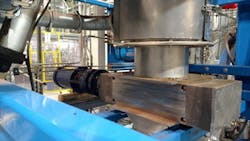Chemical makers increasingly are turning to non-food plants and otherwise unusable biomass to produce renewable raw materials for products such as paints, detergents, packaging materials, textiles and more that traditionally have been petroleum-based. This allows the companies to utilize organic materials that otherwise would go to a landfill as well as help other manufacturers in their supply chain meet the growing demand for affordable “green” products.
Renmatix, Inc., King of Prussia, Pa., has developed a process that converts plants and wood chips into essential chemical building blocks. Our patented Plantrose technology quickly turns biomass into low-cost, high-quality cellulosic sugars integral to creating biochemical and biofuel products. Our process uses supercritical hydrolysis, which unlike traditional sugar-conversion methods, eliminates the need for costly enzymes to break down original feedstock matter. Instead, hot pressurized water acts as a solvent to fractionate the biomass and separate the cellulose and lignin compounds, preserving the valuable sugars within those materials.
Our plant in Georgia operates around the clock, continuously feeding the supercritical hydrolysis process.
[javascriptSnippet ]
Chunks In Feedstock
Our biomass inputs tend to agglomerate and form big chunks during shipment to the plant. Because our conversion equipment is sensitive to large, tough debris, we must break up these larger pieces of biomass in the early stages of the process before sending feed to slurrying tanks.
When we originally developed and implemented Plantrose technology several years ago, we purchased a lump breaker to handle the woody biomass and feedstock materials.
The lump breaker uses a once-through chopping action to crush material to facilitate mixing and conveying. However, wide gaps in the unit allowed biomass chunks to pass through into the feed system. This caused troublesome clogs in the process on a daily basis, and required operators to halt the operation for up to two hours each time to remove the offending clumps. These continuous stops and starts to the system drain energy and productivity, and cause undue stress and wear on the equipment.
After conducting research on available industrial waste-reduction products, we ultimately reached out to JWC Environmental, Costa Mesa, Calif., for more information on its Monster Industrial family of waste shredders and grinders. The variety of applications the shredders handled, including similar waste-to-energy endeavors, intrigued our engineering team.
A Better Solution
We opted for a Monster Industrial 3-Shred unit (Figure 1). The grinder comprises two rows of sharp steel cutters that rotate toward one another at low speed. The cutters are stacked in a helical pattern, so the teeth reach up and proactively grab material and pull it into the grinder for reliable size reduction. The unit also has much tighter tolerances than the lump breaker we had, so the wood chunks can’t bypass the cutter stack.
Figure 1. Unit features a slim, 13-tooth cutter configuration and took only a few days to install.
“JWC Environmental worked with us to design a unit that was perfect for our needs,” says David Biondo, our senior process engineer. The Monster Industrial team worked with him to incorporate several customized features including a slim, 13-tooth cutter configuration to ensure a fine particle output of the woody biomass to prevent clogs and maintain flow. “The grinder ensures the woody material comes out the way we need it to,” Biondo notes. “It cuts, squeezes and crushes the biomass chunks and they fall apart as soon as they hit [the] slurrying feed system. The woody material goes into the grinder looking like hockey puck chunks and comes out looking like Puppy Chow pieces.”
Total purchase cost of the unit was $25,000. We were responsible for its installation, which took place in the second quarter of 2015. This involved removing the old lump breaker, fabricating some transition pieces because the grinder and lump breaker weren’t the same size, and then installing the grinder. In all, the installation process only took a few days.
The 3-Shred has solved our feed problem. Now, we can focus on commercializing the Plantrose process and boosting our business rather than spending time on equipment downtime due to clogging.
Just The Start
Renmatix is confident that cheap, abundant cellulosic sugars will foster the next wave of clean renewable fuels and chemicals. Use of these chemical building blocks will continue to reduce our dependence on petroleum and petroleum-based goods while also providing green alternatives that appeal to consumers. By supplying these key intermediary sugars at market-leading prices, Renmatix is helping open the door to an accelerated, large-scale bio-based industrial revolution. Ensuring our system can run the way it should — without pipeline clogs or system interrupts — is essential to that process.
MIKE SIMARD, PE, is engineering director at Renmatix, Inc., King of Prussia, PA. E-mail him at [email protected].

